WWII Japanese Military Sword (Shin-Gunto)

Mounting Terms Blade Holder Tassel Metal Parts Color Examples Epilogue Shop
WWII Japanese Military Sword (Shin-Gunto)

Mounting Terms Blade Holder Tassel Metal Parts Color Examples Epilogue Shop
RARE WWII Gunto & Gendaito Sword book is on sale now.
Copyright 2004, Ohmura
Tomoyuki & Jinsoo Kim
No part of this website can be reproduced or
copied without author's permission
To date, gunto has been just regarded as poor-made swords used in WWII. Japanese have had bad memory about them while they were war trophies to the US veterans. Fukunaga sensei once criticized that the term "Bijutsu Token (Art sword)" was the product of defeatistic view of postwar history. Sword should be the weapon at first and its aesthetics is the next. The gunto was used in the real battle and soldiers died with their swords like samurais. In this point, each gunto has its own vivid history and there are many respectible aspects which should be appreciated.It's my great honor to translate and elaborate Mr.Ohmura Tomoyuki's Gunto Site. He did an excellent job to enlighten the beauty of gunto.
 |
 |
Army
sword
(1938-1943) |
 |
 |
Navy
sword
(1937-1945) |
Gunto MountingSince the foundation of Japanese military force, there were military sabres in army and navy. In Showa 9th year (1934, Koki 2594), army made their first Japanese Tachi style gunto so called "94 shiki". The 94 was from the last two digits of Koki chronology. It has two chyokans (rings) on saya. In Showa 12th (1937), navy made the same style with two rings mounted gunto. In Showa 13th (1938, Koki 2598), army changed its gunto with one ring mounting style. This is "98 shiki" shin-gunto we come across frequently. In Showa 18th (1943, Koki 2603), army rechanged to simplify and this mounting is less decorated comapred to previous versions because of the lack of materials during the war. This called "3 shiki" style.
The dignity of gunto mounting can be decided considering many factors rather than its simple look. At first, the number of seppa. In the case of army, sukashi sakura tsuba is another important factor. The first class mounting has 4 seppas with one big seppa and three small seppa. 2nd or 3rd classes and later versions have missed redundant seppas but, in principle, there were 4 seppas both for amry and navy styles.
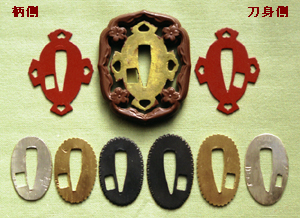 |
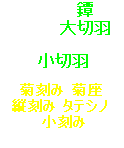
Above center: tsuba Above left & right: o-seppa Below: ko-seppa (Kiku kizami (Kikuza), Tate kizami (Tateshino), Ko kizami from the center to sides) |
 |
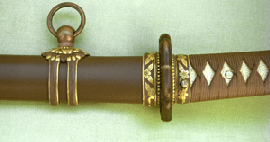
|
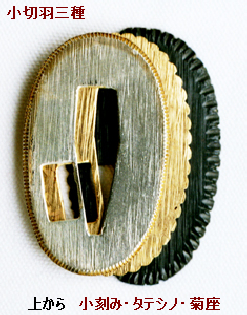
Three
kinds of ko-seppa
|
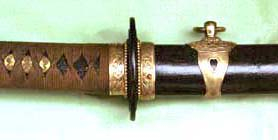
|